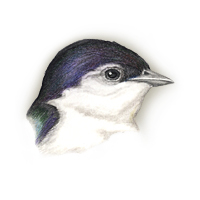|
Field
Guide IDs: BREEDING:
Conif or decid open
forest or woodland, often at higher altitudes. 1
brood. DISPLAYS:
Predawn
song-flights may be part of courtship. NEST:
In tree hole or
other cavity; of grass and weed stems, lined with
feathers. EGGS:
White, unmarked.
0.8" (19 mm). DIET:
Insects only rarely
taken on ground. CONSERVATION:
Winters s to
Honduras. Forestry practice of removing standing
dead trees has greatly reduced availability of
natural nest sites; will use nest boxes. NOTES:
Occ nest in loose
colonies of up to 20 pairs. Defends area around
nest hole from other cavity-nesting species of
swallows. Several pairs have been documented
helping Western Bluebirds to rear nestlings and
subsequently breeding in the nest box after the
bluebirds fledge. Like other swallows, often
perches in long rows on wire. House Sparrows
compete for nest cavities. Flocks occ with Tree
Swallows. Uncommon to fairly
common migrant and summer resident. Large flocks of
migrants or post-breeding individuals occasionally
forage or roost on campus. Small numbers nest in
natural cavities and woodpecker holes (especially
near the Dish), and occasionally in crevices and
cavities in buildings on
campus.....Similar
Species: Tree
Swallow ESSAYS: Communal
Roosting;
Wing
Shapes and Flight;
Bathing
and Dusting;
Coloniality REFERENCES:
Brown, 1983;
Eltzroth and Robinson, 1984; Ersidne,
1984. |
